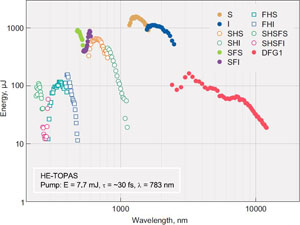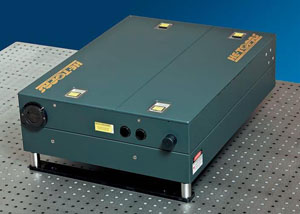Femtosecond Lab Equipment
The CPA series from Clark-MXR, Inc. is a fully integrated regeneratively amplified kHz Ti:Sapphire laser system. Complete control of important laser functions can be performed via an included touch-screen controller or from any Windows-based computer with a network connection. Computer controlled functions of laser parameters include power output, pulse width, pump power, timing, and selection of single pulse or groups of multiple pulses. The user interface provides both status information and control from external devices. This fully integrated system includes the seed laser and its associated diode laser pump, pulse stretcher, Ti:Sapphire regenerative amplifier and its associated pump laser (doubled Nd:YAG laser in separate compartment), and pulse compressor.
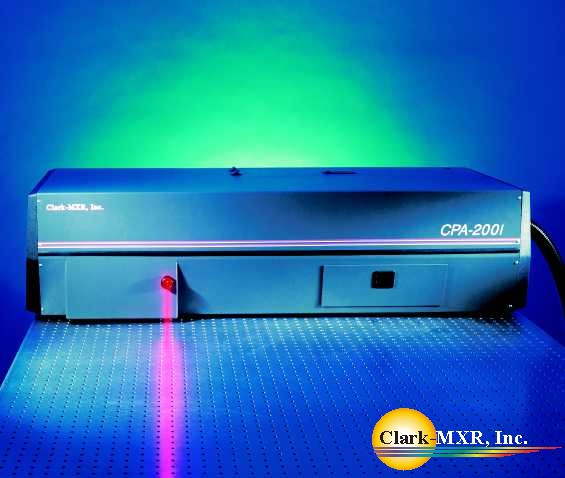
Clark-MXR CPA-2110 Specs:
- Pulse Energy: > 1 mJ @ 1kHz, > 0.6 mJ @ 1-2 kHz
- Pulse Width: < 150 fs
- TBWP: < 1.4 x transform limit of sech2
- Oscillator Wavelength Output: 775 nm
- Oscillator Power Output: 3 mW
- Oscillator Repetition Rate: 30 MHz, nominal
- Wavelength: 775 nm
- M2 : 1.2 ± 0.1
- Repetition Rate: User adjustable up to 2 kHz
- Polarization: Linear, horizontal
- Energy Stability: < 1 % rms
- Beam Diameter: 4-6 mm (FWHM)
- Beam Divergence: < 100 µradians
- Transverse Mode: TEM00
Pump Requirements
- Wavelength: 770 – 830 nm
- Pulse Width: 20 to 300 fs (FWHM)
- Pulse Energy: 0.15 to 5 mJ
- Maximum average power: 5 W
- Polarization: horizontal
- Beam Divergence: M2 < 1.5
- Energy instability: < 2% peak-to-peak
- Spatial Profile: Gaussian
Output from TOPAS (for 1 mJ, 100 fs input):
- Tuning Range (signal + idler): 1150 nm – 2500 nm
- Energy (signal + idler): > 250 µJ at peak
- Pulse Duration: 0.7 to 1.0 x pump pulse width
- Polarization: signal (vertical) ; idler (horizontal)
- Energy instability: 4% rms
Output from Mixer Crystals (for 1 mJ, 100 fs input):
- Second Harmonic of signal (SHS): 580 – 800 nm
- Second harmonic of idler (SHI): 800 – 1150 nm
- Sum Frequency of Signal (SFS): 475 – 533 nm
- Sum Frequency of Idler (SFI): 533 – 600 nm
- Difference Frequency (DFG): 2.4 – 11 µm
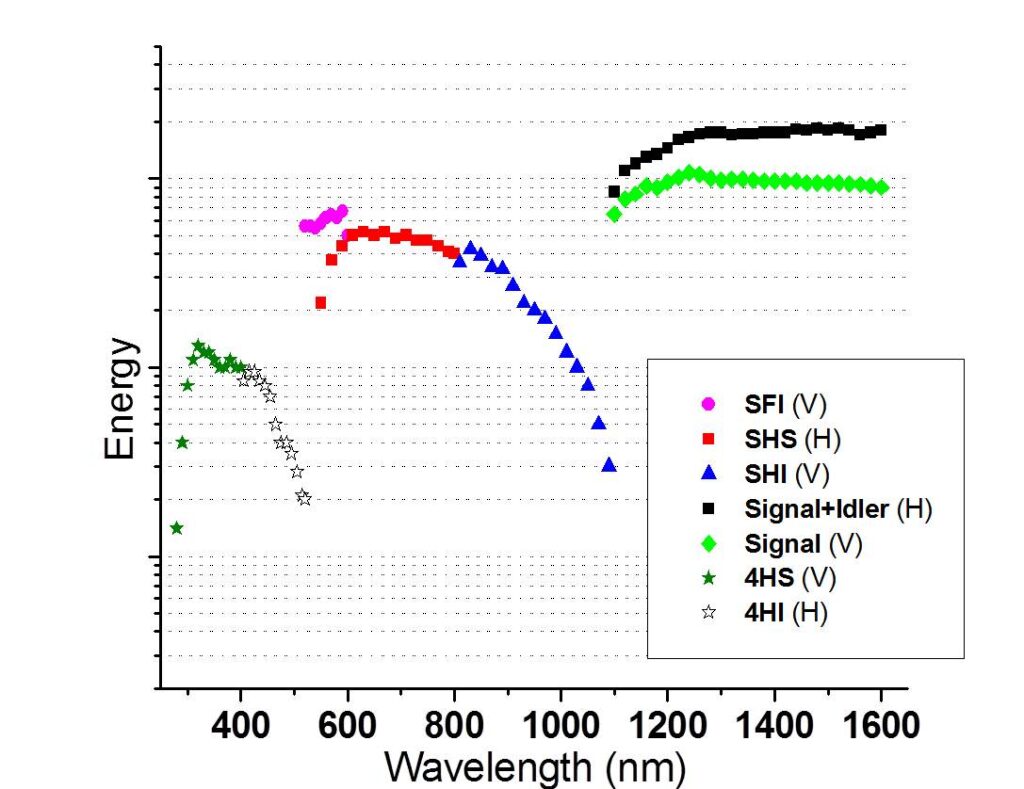
Pump Requirements:
- Wavelength: 770 – 830 nm
- Pulse Width: 20 to 300 fs (FWHM)
- Pulse Energy: 0.15 to 5 mJ
- Maximum average power: 5 W
- Polarization: horizontal
- Beam Divergence: M2 < 1.5
- Energy instability: < 2% peak-to-peak
- Spatial Profile: Gaussian
Output from TOPAS (for 1 mJ, 100 fs input):
- Tuning Range (signal + idler): 1100 nm – 2600 nm
- Energy (signal + idler): > 250 µJ at peak
- Pulse Duration: 0.7 to 1.0 x pump pulse width
- Polarization: signal (vertical) ; idler (horizontal)
- Energy instability: < 2% rms
Output from Mixer Crystals (for 1 mJ, 100 fs input):
- Second Harmonic of signal (SHS): 550 – 800 nm
- Second harmonic of idler (SHI): 800 – 1150 nm
- Sum Frequency of Idler (SFI): 533 – 600 nm
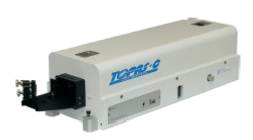
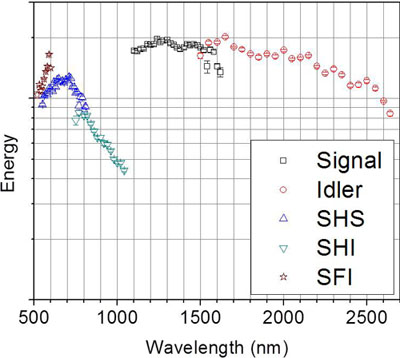
Pump Requirements:
- Wavelength: 770 – 830 nm
- Pulse Width: 80 to 150 fs (FWHM)
- Pulse Energy: 0.2 to 1 mJ
- Polarization: horizontal
- Beam Divergence: M2 < 1.5
- Energy instability: < 1% rms
- Spatial Profile: Gaussian – Hyper Gaussian
Output from TOPAS:
- Tuning Range (signal): 500-750 nm and 850-1000 nm
- Energy (signal): > 30 µJ @ 550 nm and > 16 µJ @ 700 nm
- Pulse Duration: < 25 fs @ 530-700 nm; < 70 fs rest of range
- Polarization: signal (vertical); idler (horizontal)
- Energy instability: < 9% rms
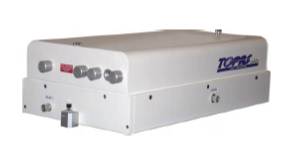
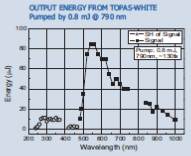
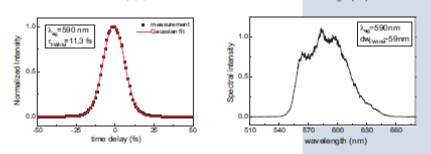
The fluorescence spectrofluorimeter is used to measure one and two photon fluorescence of different materials. The fluorimeter also allows for the acquisition of anisotropy measurements. For two-photon fluorescence, we couple light from our kHz, fs Ti:Sapphire laser to measure the induced one-photon fluorescence from two-photon excitation by operating in analog mode.
System Includes:
- Continuous wave Xenon lamp
- Adjustable slits
- Excitation Monochromator
- Excitation Grating (2)
- 600 lines / mm blazed grating
- 1200 lines / mm blazed grating
- Sample Compartment
- Excitation Correction
- Emission Monochromator
- Emission Grating
- 2 Visible PMT (350-750 nm) and 1 NIR PMT Detector (up to 1.7 µm)
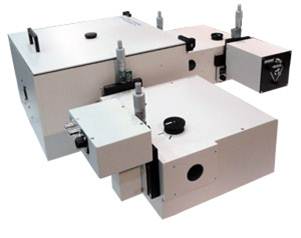
Features
- High Energy, high efficiency design (up to 12.0 mJ)
- Integrated Evolution HE pump laser
- Thermally stabilized E-2 Engine regenerative amplifier platform
- Two-stage, TE-cooled power amplifier (Regenerative + single pass)
- High reliability, high contrast ratio optical design
- Unsurpassed stability – energy, pointing, pulse width
- Pulse widths from <25 fs to 1.5 ps
Main Specifications
- Pulse Energy: >12 mJ @ 1kHz
- Pulse Width: <35 fs (FWHM)
- Oscillator: VitaraTM-T
- Oscillator Wavelength Output: 800 nm
- Oscillator Power Output: >525 mW (minimum bandwidth)
- Oscillator Repetition Rate: 80 MHz, nominal
- Amplifier Wavelength: 800 nm
- M2: <1.35
- Repetition Rate: User adjustable
- Polarization: linear, horizontal
- power stability: < 0.5% RMS
- Beam Diameter: ~12 mm (FW1/e2M)
- Beam pointing stablity: < 10 µradians (rms)
- Transverse Mode: TEM00
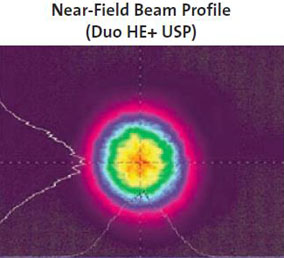
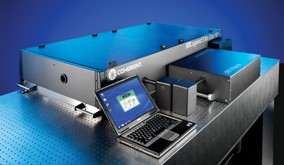
Features
- Travelling wave three/five amplification stages configuration.
- Energy conversion into the parametric radiation ~30-35%.
- Angular tuning limited by crystal transparency range only.
Output from TOPAS (for 10 mJ input, 20-60 fs input)
- Tuning range (signal + idler): 1140 nm – 2600 nm
- Energy (signal + idler): > 2500 µJ at peak
- Pulse Duration: 1.2 to 1.5 × pump pulse width
- Polarization: signal (vertical) idler (horizontal)
- Energy instability: < 3% rms
